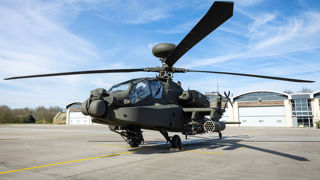
Boeing AH-64E Apache Guardian
The AH-64 Apache was originally developed by Hughes Helicopters for the US Army as an anti-tank attack helicopter. The original AH-64A entered US Army service in 1986 and featured advanced targeting systems, including sensors that were slaved to gunners/pilots' line of sight via their helmets, as was the helicopter's 30mm cannon. Developments of the AH-64 resulted in the new-build AH-64D Apache Longbow, which included the AN/APG-78 mast-mounted Longbow Radar which allowed the Apache to track up to 128 targets and engage the 16 highest threats at once from behind cover using a new radar-guided version of the Hellfire. The most recent version is the AH-64E Guardian, renamed from the AH-64D Block III. The Guardian uses more powerful engines and has the ability to directly control drones, the radar has also seen a significant upgrade, and the fuselage/rotors are now capable of being used aboard ships.
The Royal Netherlands Air Force, known as the Koninklijke Luchtmacht (KLu), began operating the AH-64D in 1998 from Gilze-Rijen Air Base after ordering 30 examples in 1995. The Apache has seen extensive service with the KLu and have been deployed on combat operations to Africa and Iraq, in addition to peacekeeping operations in Bosnia. Their most notable combat success however has been in Afghanistan supporting allied operations against the Taliban. The KLu have been upgrading their fleet to AH-64E standard via a remanufacturing program in the US and the first Apache Guardians were delivered to Gilze-Rijen during March 2024.
As part of our celebration of 50 years since the Apache first flew, the KLu will be providing one of their AH-64E Apache Guardians for static display at RIAT25. The helicopter will be provided by the 301 squadron.
Photo Credit: Koninklijke Luchtmacht
On display
| Role | Friday | Saturday | Sunday |
|---|---|---|---|
| Static | No | Yes | Yes |